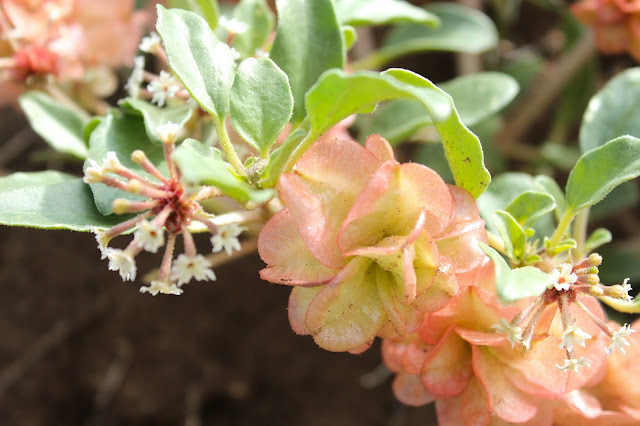This week I'm sharing some plants of deserty places--Great Sand Dunes, Mesa Verde, and Black Canyon of the Gunnison--although they're not necessarily plants confined to dry land.
The Great Sand Dunes covers a wide range of landscapes--from the nearly (but not entirely) bare sand to alpine areas. The area we visited was generally dry and deserty, although this first plant is one of wet areas--Rocky Mountain beeplant (Cleome serrulata) must be enjoying the wet spring and early summer, because it was blooming all around the campground. (Caper family).
This plant had me all kinds of confused--those were white flowers, but what on earth were the flowery beneath the leaves? It turns out they're the seed pods of the small-flowered sand verbena (Tripterocalys micranthus). It reminds me of the hoya I have in a pot, but that's a member of another family (milkweed) altogether. (Four o' clock family).
More Lupins (Lupinus spp.). There are something like a dozen species growing in Colorado.
I'm not sure what this one is, but I think it might be a scrawny miner's candle (Cryptantha virgata).
These gorgeous musk thistles (Cardus nutans) grew all around the campgrounds at Mesa Verde, and in the roadside areas approaching the park. They're an invasive species, but I love the way they look so much (like an artichoke!).
This red penstemon (Penstemon spp.) superficially resembles fairy trumpets and the two are a good example of convergent evolution--nice long, red tubes for feeding hummingbirds. (Plantain family).
This is just one of several species of Indian paintbrush we saw throughout all of the habitats (Castilleja spp.) we spent time in. Broomrape family.
Here is another:
We saw cholla cactus (Cylindropuntia spp.) blooming in the fields all along the highway on our drive south from Denver, but once we finally hit a rest stop, I could find none nearby to photograph, to my disappointment. But then there was just one big plant growing in the natural gardens outside of the museum in Mesa Verde that I was able to capture.
When we went back the next day, there were even better blossoms.
This fluffy, fun, Dr. Seuss-looking flower is prince's plume (Stanleya pinnata). We saw it growing along the rocks and cliffs when we were hiking in Mesa Verde. (Mustard family).
These are the ecstatic seed plumes of clematis (Clematis ligusticifolia). (Buttercup family).
I took the picture of this pretty little bud during an early morning bird walk. It looks straight out of a fairy tale. I didn't know what it was, and sort of forgot about it until I was looking at my pictures and saw the next one, and realized this bud is just a baby mariposa lily.
My dad found just one of these Gunnison's sego, or mariposa, Lily (Calochortus gunnisonii) growing among the tall grass near our campsite, but when we got to Black Canyon they were growing everywhere. I'm not sure what "sego" means, but "mariposa" is Spanish for "butterfly" and is the perfect name for these lovelies. (Lily family).
These little guys, which are like asters with a million ray flowers are called showy daisies (Erigeron speciosus), and they were blooming like crazy at both Mesa Verde and Black Canyon. (Aster family).
This pretty white flower is from the mock orange bush (Philadelphus icrophylius). (Hydrangea family).
Many people think of deserts (or semi-deserts, which might be a more technically accurate description of the areas we were in) as barren wastelands, and they have been abused accordingly, but really they are rich with a wide array of plants and animals--and lichens and fungi.
























Lovely and informative. :-)
ReplyDeleteThanks, Sarah!
DeleteIt is lovely to see flowers from other parts of the world some similar but most so different. Thank you for sharing :)
ReplyDeleteIt is fascinating how much diversity is out there!
DeleteI love seeing flowers from different parts of the world. Thanks for sharing!
ReplyDeleteMe, too! And I'm loving finally learning their names.
DeleteThis is a great post - with so many lovely photographs! Plants that can survive with such an economical use of water are my favorites. :)
ReplyDeleteThank you so much, Kelly, and thanks for stopping by. Yes, I am completely in awe of plants (and animals) that make their homes in harsh or extreme climates.
DeleteAmazing flowers. I don't think I have seen any of them before! Maybe it's because I live in Ohio?
ReplyDeleteThanks, Channon! A lot of them are pretty unique to the southwest, I think. Thanks for stopping by!
DeleteWow, most of the flowers in this post I had never seen. Just gorgeous...
ReplyDelete